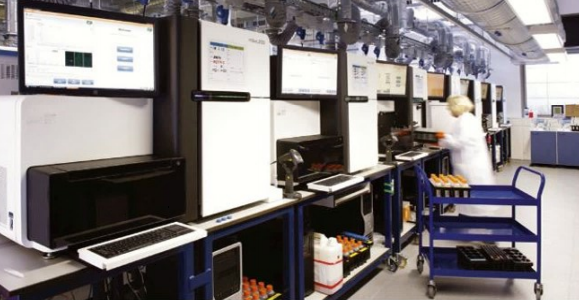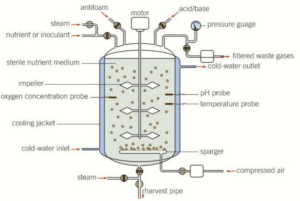Culturing microorganisms in the laboratory and on an industrial scale.

Culturing microorganisms in the laboratory
To investigate microorganisms for the medical diagnosis of disease or scientific experiments you need to culture them.
This often involves growing large enough numbers of microorganisms for us to see them clearly with the naked eye.
Whenever microorganisms are cultured in the laboratory the correct health and safety procedures must be followed because even when the microorganisms are expected to be completely harmless:
- there is always the risk of a mutation taking place making the strain pathogenic
- there may be contamination with pathogenic microorganisms from the environment.
Culturing microorganisms
The microorganisms to be cultured need food as well as the right conditions of temperature, oxygen, and pH.
The food provided for microorganisms is known as the nutrient medium.
It can be either in liquid form (broth) or in solid form (agar).
Nutrients are often added to the agar or the broth to provide a better medium for microbial growth.
Some microorganisms need a precise balance of nutrients but often the medium is simply enriched with good protein sources such as blood, yeast extract, or meat.
Enriched nutrient media allow samples containing a very small number of organisms to multiply rapidly.
The nutrient medium must be kept sterile (free from contamination by microorganisms) until it is ready for use.
Aseptic techniques are important.
Once the agar or nutrient broth is prepared the bacteria must be added in a process called inoculation.
Inoculating broth
- Make a suspension of the bacteria to be grown.
- Mix a known volume with the sterile nutrient broth in the flask.
- Stopper the flask with cotton wool to prevent contamination from the air.
- Incubate at a suitable temperature, shaking regularly to aerate the broth providing oxygen for the growing bacteria.
Inoculating agar
This also involves a suspension of bacteria but the process is slightly more complicated.
- The wire inoculating loop must be sterilized by holding it in a Bunsen flame until it glows red hot.
- It must not be allowed to touch any surfaces as it cools to avoid contamination.
- Dip the sterilized loop in the bacterial suspension.
- Remove the lid of the Petri dish and make a zig-zag streak across the surface of the agar.
- Avoid the loop digging into the agar by holding it almost horizontally.
- However, many streaks are applied, and the surface of the agar must be kept intact.
- Replace the lid of the Petri dish.
- It should be held down with tape but not sealed completely so oxygen can get in, preventing the growth of anaerobic bacteria.
- Incubate at a suitable temperature.
Several limiting factors prevent exponential growth in a culture of bacteria. These include:
- Nutrients available – initially there is plenty of food, but as the numbers of microorganisms multiply exponentially it is used up. The nutrient level will become insufficient to support further growth and reproduction unless more nutrients are added.
- Oxygen levels – as the population rises, so does the demand for respiratory oxygen so oxygen levels can become limiting.
- Temperature – the enzyme-controlled reactions within microorganisms are affected by the temperature of the culture medium. For most bacteria, a low temperature slows down growth and reproduction, and a higher temperature speeds it up. If the temperature gets too high it will denature the enzymes, killing the microorganisms – even thermophiles have a maximum temperature they can withstand.
- Build-up of waste – as bacterial numbers rise, the build-up of toxic material may inhibit further growth and can even poison and kill the culture.
- Change in pH – as carbon dioxide produced by the respiration of the bacterial cells increases, the pH of the culture falls until a point where the low pH affects enzyme activity and inhibits population growth.
Culturing microorganisms on an industrial scale
In any bioprocess, the microorganism involved must be able to
- synthesize or break down the chemical required,
- work reasonably fast,
- give a good yield of the product,
- use relatively cheap nutrients,
- and not require extreme (and therefore expensive) conditions.
- It must not produce any poisons that contaminate the product
- or mutate easily into non-functioning forms.
Primary and secondary metabolites
What is wanted from the microorganisms varies from one bioprocess to another.
Sometimes, you would want as many microorganisms as possible, because the microorganism itself is the product to be sold,
For example, single-celled protein such as Quorn, or baker’s yeast.
Sometimes, substances are wanted which are formed as an essential part of the normal functioning of a microorganism.
For example, ethanol (a product of anaerobic respiration in yeast), ethanoic acid, and a range of amino acids and enzymes.
They are known as primary metabolites.
In some circumstances, organisms produce substances that are not essential for normal growth but are still used by the cells.
Examples include many pigments, and the toxic chemicals plants produce to protect themselves against attack by herbivores.
The organism would not suffer, at least in the short term, without them.
These chemicals are known as secondary metabolites, and they are often the required product in a bioprocess, for example, penicillin and many other antibiotics.
Types of bioprocesses
Once a microorganism has been chosen, and the ideal size and shape of the bioreactor (reaction vessel) decided, the organization of the commercial production has to be decided. Two of the main ways of growing microorganisms are
- batch fermentation
- and continuous fermentation.
Batch fermentation
- The microorganisms arc inoculated into a fixed volume of medium.
- As growth takes place, nutrients are used up and both new biomass and waste products build up.
- As the culture reaches the stationary phase, overall growth ceases but during this phase, the microorganisms often carry out biochemical changes to form the desired end products (such as antibiotics and enzymes).
- The process is stopped before the death phase and the products are harvested. The whole system is then cleaned and sterilized and a new batch culture is started up.
Continuous culture
- Microorganisms are inoculated into a sterile nutrient medium and start to grow.
- Sterile nutrient medium is added continually to the culture once it reaches the exponential point of growth.
- Culture broth is continually removed from the medium, waste products, microorganisms, and products keep the culture volume in the bioreactor constant.
Continuous culture enables continuous balanced growth, with levels of nutrients, pH, and metabolic products kept more or less constant.
Both methods of operating a bioreactor can be adjusted to ensure either the maximum production of biomass or the maximum production of primary or secondary metabolites.
Most systems are adapted for maximum yield of metabolites.
The majority of industrial processes use batch or semi-continuous cultivation.
Continuous cultivation is largely used for the production of single-celled protein and in some wastewater treatment processes.
All bioreactors produce a mixture of unused nutrient broth, microorganisms, primary metabolites, possibly secondary metabolites, and waste products.
The useful part of the mixture has to be separated by downstream processing.
This is one of the most difficult and expensive parts of the whole bioprocess the percentage of the total cost of a product which is due to downstream processing costs varies from 15-40%.
Controlling bioreactors
Whether a bioreactor is simply a container containing microbial broth or a complex aseptic fermenter, it is very important to control and manipulate the growing conditions to maximize the yield of the product required.

Factors which need to be controlled include:
Temperature
If the temperature is too low the microorganisms will not grow quickly enough.
If the temperature gels loo high, enzymes start to denature and the microorganisms are inhibited or destroyed.
Bioreactors often have a healing and/or a cooling system linked to temperature sensors and a negative feedback system to maintain optimum conditions.
Nutrients and oxygen
Oxygen and nutrient medium can be added in controlled amounts to the broth when probes or sample tests indicate that levels are dropping.
Mixing things up
Inside a bioreactor, there are large volumes of liquid, which may be quite thick and viscous due to the growth of microorganisms.
Simple diffusion is not enough to ensure that all the microorganisms receive enough food and oxygen or that the whole mixture is kept at the right temperature, so most bioreactors have a mixing mechanism and many are stirred continuously.
Asepsis
If a bioprocess is contaminated by microorganisms from the air, or workers, it can seriously affect the yield.
To solve this problem most bioreactors are sealed, aseptic units.
If the process involves genetically engineered organisms, it is a legal requirement that they should be contained within the bioreactor and not be released into the environment.






